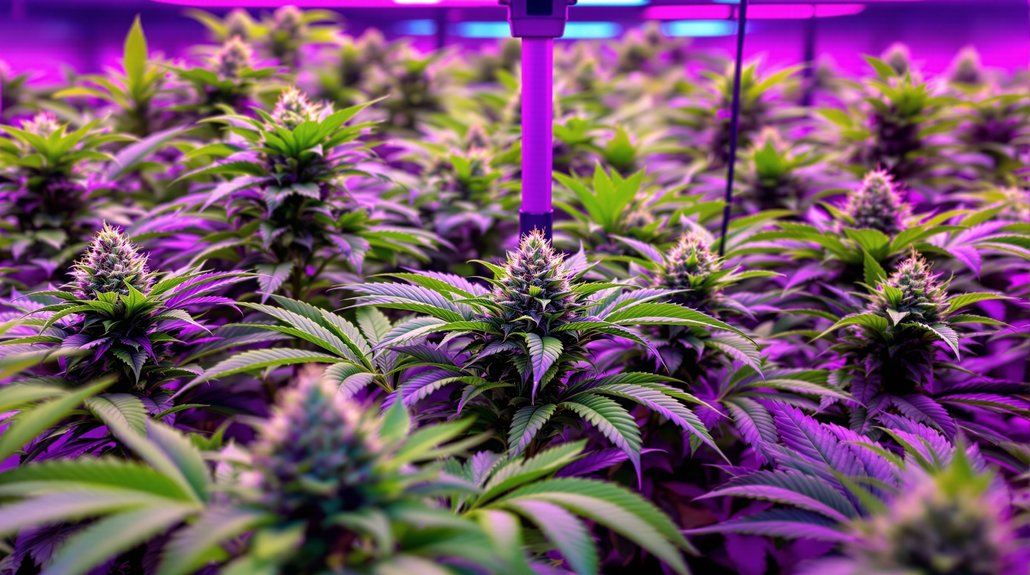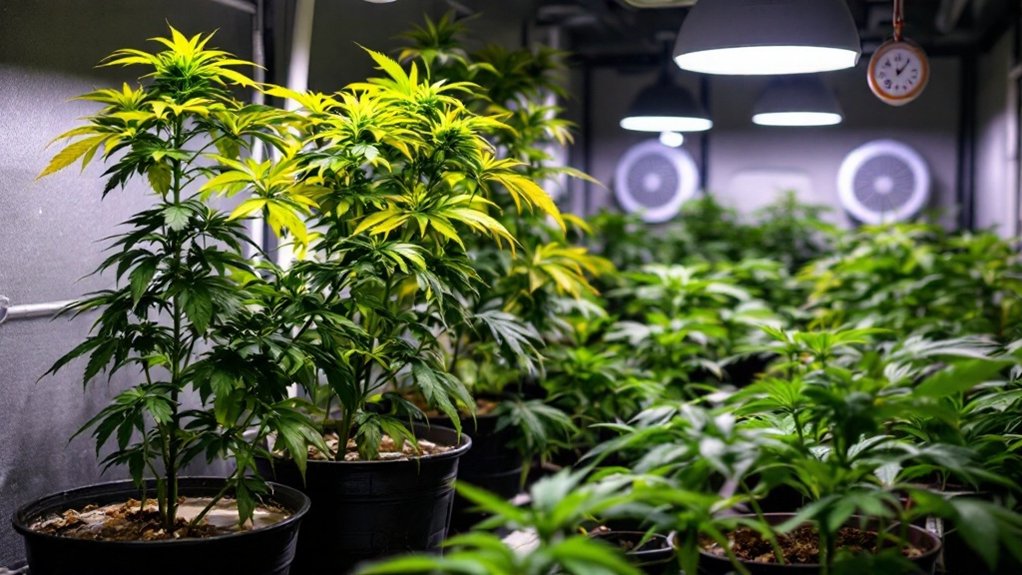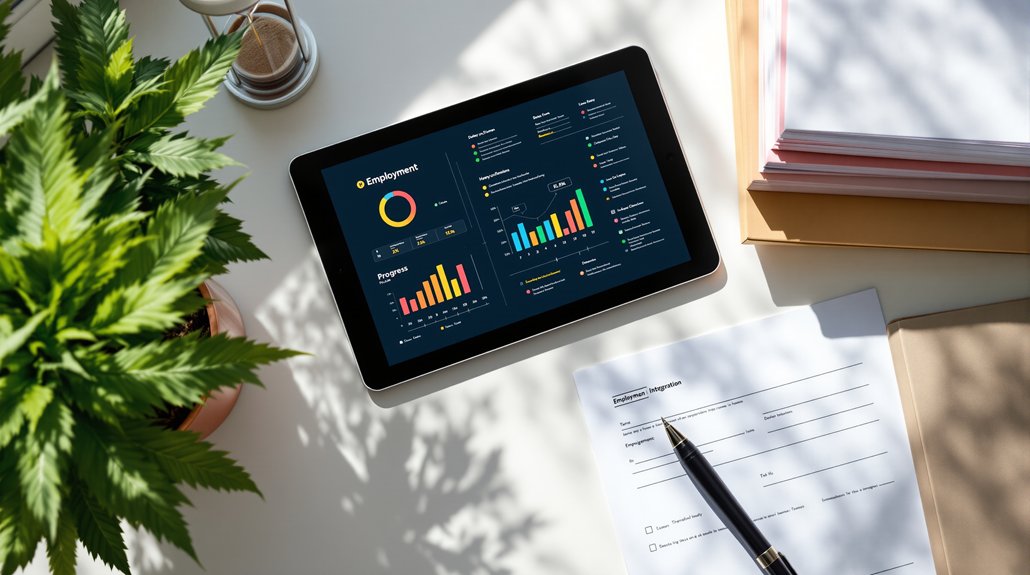Commercial Property Checklist
Real estate decisions can make or break a cannabis business. From navigating complex zoning laws to securing financing without traditional banks, cannabis operators face unique challenges that require specialized knowledge and strategic planning.
This guide walks you through the complete real estate journey, from finding your first compliant site to scaling across multiple markets. We focus on cannabis-specific hurdles and practical solutions, so you can make informed decisions that keep you compliant, operationally efficient, and positioned for growth.
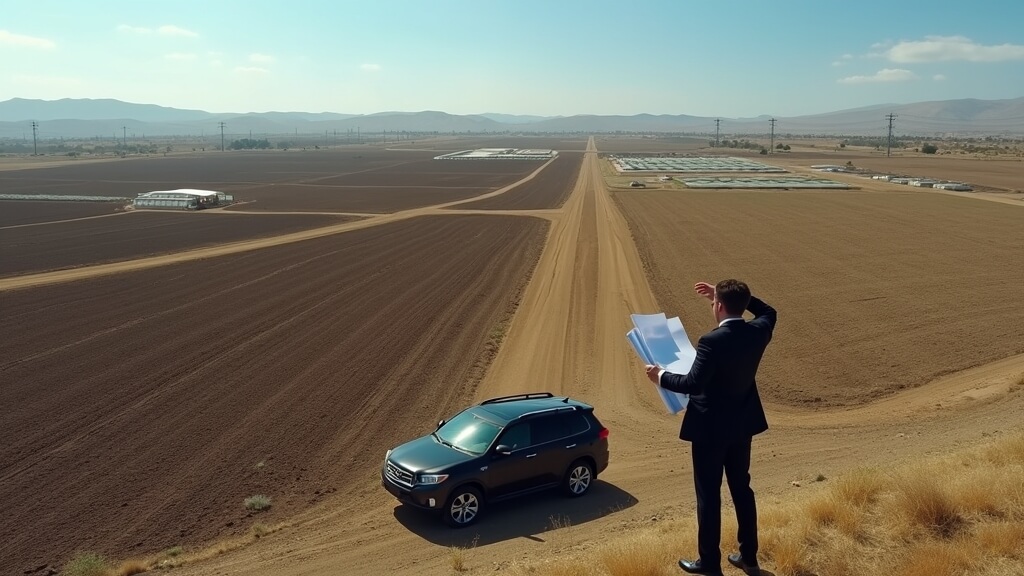
Phase 1: Site Selection & Due Diligence
The Zoning Challenge: Finding Your Green Zone
Cannabis-friendly real estate exists in limited “green zones” dictated by state and local regulations. In California alone, all 482 cities and 58 counties can set their own cannabis land-use rules, creating a complex patchwork of restrictions.
Buffer Zone Requirements create the biggest limitations. Most jurisdictions require cannabis businesses to maintain distances of 600-1,000 feet from schools, with additional buffers from daycares, parks, and houses of worship. New York dispensaries, for example, must stay 500+ feet from schools and 200+ feet from religious buildings.
Local Control Variations mean what’s legal in one city may be banned in the neighboring town. Many states give municipalities complete autonomy over cannabis zoning, resulting in dramatically different rules across jurisdictions. Some welcome cannabis businesses in industrial zones while others impose outright bans.
Concentration Limits prevent cannabis clustering through license caps or distance requirements between dispensaries. Cities like Los Angeles limit retailers per Community Plan Area to avoid undue concentration, while limited-license states like Illinois and Florida control competition through license counts rather than unlimited expansion.
The key insight: tight zoning creates extreme competition for compliant properties, often driving landlords to charge significant premiums. Operators frequently face the choice between prime locations with inflated rents or secondary locations that meet budget constraints but may limit business potential.
Market Dynamics and Location Strategy
Beyond regulatory compliance, smart operators analyze market saturation and competitive dynamics. Mature markets like Colorado, Washington, and Oregon often face oversupply challenges, while emerging markets with limited licenses see pent-up demand and growth opportunities.
Understanding Market Maturity helps inform location strategy. Oregon’s oversupply led to widespread business closures, while New York’s adult-use rollout in 2024 generated a 209% jump in cannabis jobs as the market expanded. California’s well-established market saw significant industry job losses due to oversaturation and high taxes.
Operation-Specific Considerations matter significantly. Cultivators often prioritize areas with lower costs and cheap power, but must balance this against distribution logistics. Retailers need visibility and foot traffic within narrow green zones. Vertically-integrated operators face the complex challenge of locating cultivation and processing in industrial areas while placing retail in population centers.
Identifying Opportunities in underserved markets can provide competitive advantages. Some regions have “dispensary deserts” where local bans create large areas without legal retailers. These represent potential opportunities if policy changes or if operators can find welcoming jurisdictions nearby.
Environmental Due Diligence: Avoiding Hidden Costs
Cannabis businesses frequently repurpose old warehouses and industrial sites, which can harbor environmental liabilities. Comprehensive environmental due diligence prevents costly surprises and regulatory complications.
Contamination Risks pose the greatest threat. Once you purchase property, you may become liable for cleaning up pre-existing contamination, even from past occupants. Converting an old factory could expose you to expensive soil cleanup if previous tenants dumped solvents or chemicals. Phase I Environmental Site Assessments should be standard practice, with Phase II testing if issues emerge.
Building Hazards commonly found in older cannabis-suitable properties include asbestos insulation, lead-based paint, and mold from roof leaks. These hazards require proper abatement during renovations and can significantly impact build-out budgets and timelines.
Cannabis-Specific Environmental Compliance adds another layer of complexity. California mandates that cultivators secure water rights and avoid dry-season stream diversions, requiring winter rainwater capture for summer use. Extraction labs must comply with air quality and hazardous waste regulations, while cultivation odor may trigger local air quality permits.
The bottom line: environmental cleanups can devastate budgets and timelines. One Humboldt County cultivator faced a $750,000 fine for water violations and was forced to restore damaged land. Proper due diligence and expert consultation prevent these expensive setbacks.
Infrastructure Assessment: Power, Water, and Utilities
Cannabis operations are exceptionally resource-intensive. Indoor cultivation uses up to 10 times more electricity per square foot than typical offices, while water demands can be substantial for both cultivation and processing.
Electrical Capacity represents the biggest infrastructure challenge. Indoor cannabis farming now accounts for about 1% of all U.S. electricity usage, projected to reach 3% by 2035. Many older industrial properties lack sufficient power service for large grows, and utility upgrades can require months and substantial fees. A 60,000 square foot facility might need 2-3 times the power of a normal warehouse that size.
Before committing to any location, obtain a utility power availability letter. Understand current amperage and voltage capacity, and confirm what upgrades would cost and how long they’d take. Engaging an electrical engineer early to calculate projected load helps utilities provide realistic timelines and costs.
Water Rights and Supply become critical for cultivation operations, especially in water-constrained regions. California’s cannabis cultivation policy prohibits surface water diversions during dry seasons without storage, requiring growers to invest in winter storage infrastructure. Rural operations using well water must test yield and recovery rates, while municipal operations should verify adequate line capacity.
Waste Management Systems require special consideration due to cannabis-specific disposal requirements. Plant material waste typically must be rendered unusable before leaving facilities, requiring secure storage and specialized disposal procedures. Labs using solvents generate hazardous waste requiring licensed disposal companies.
Smart operators budget substantial contingency funds for utility upgrades and engage with utility companies early in the site selection process. Infrastructure limitations discovered late in the process can derail entire projects.
Community Relations: Building Local Support
Even after finding a compliant, well-equipped site, winning community and government support often determines project success. Cannabis businesses face unique scrutiny and must proactively address concerns.
Public Hearings and Local Approval processes typically involve community input where neighbors may raise concerns about traffic, odor, crime, or other impacts. Successful operators develop community outreach strategies before these hearings, including presenting security plans, addressing concerns directly, and demonstrating commitment to being good neighbors.
Engaging Local Officials early builds crucial relationships. Planning departments, council members, and police chiefs often worry about security and regulatory compliance. Transparent communication, detailed security presentations, and invitations to tour existing facilities help address these concerns.
Managing Stigma remains an ongoing challenge despite legalization. Emphasizing security measures that actually deter area crime, highlighting economic benefits like jobs and tax revenue, and actively participating in local business communities helps establish cannabis operations as normal businesses rather than controversial newcomers.
The investment in community relations pays dividends through smoother permitting, operational flexibility, and long-term business sustainability. Local opposition can kill projects even when all technical requirements are met, while community goodwill smooths operations and expansion plans.

Phase 2: Acquisition & Financing
The Alternative Financing Landscape
Traditional bank loans remain largely unavailable to cannabis operators due to federal illegality, forcing creative financing approaches for real estate acquisitions and improvements.
Limited Bank Participation exists through a handful of state-chartered banks and credit unions, but these institutions remain risk-averse and typically serve only the most qualified borrowers with strong collateral. Terms are less favorable than mainstream real estate loans, and availability varies significantly by state.
Private and Hard Money Lenders provide the bulk of cannabis real estate financing, though at higher costs. Private lenders typically offer loans at 10-14% interest with loan-to-value ratios around 65%, while hard money lenders charge 15-20% interest and often cap LTV at 50%. These lenders may only extend short-term loans requiring refinancing or balloon payments.
Cannabis REITs and Sale-Leasebacks have emerged as prominent financing alternatives. Companies like Innovative Industrial Properties purchase properties and lease them back to operators for 15-20 years under triple-net lease structures. This provides immediate capital for build-outs or operations in exchange for long-term rental obligations. However, operators must carefully model whether projected revenues can support often-high rental rates, especially during market downturns.
Creative Financing Solutions include equity partnerships, seller financing in rare cases, and development companies that build and lease cannabis facilities. Joint ventures where real estate investors buy properties while operators focus on business operations can align incentives while conserving operator capital.
The key challenge: cannabis financing costs double or triple typical market rates, directly impacting profitability. Combined with 280E tax limitations, high capital costs can severely constrain cash flow and growth.
Section 280E Tax Implications
IRC Section 280E, which disallows deductions for businesses dealing with Schedule I substances, significantly impacts real estate decisions and effective operating costs.
Rent Becomes Non-Deductible for most cannabis retailers and distributors, meaning lease payments provide no federal tax benefits. This effectively makes rent much more expensive after-tax, as operators pay taxes as if rent were pure profit. A $100,000 annual rent payment that might normally save $21,000 in corporate taxes becomes a full $100,000 cost under 280E.
Ownership Provides Strategic Advantages for cultivators and manufacturers who can capitalize facility costs into inventory as Cost of Goods Sold. Depreciation of buildings and mortgage interest may be partially allocated to COGS and thus become deductible, providing tax relief unavailable to lessees.
Separate Entity Structures offer tax mitigation strategies. Many operators create PropCo (Property Company) entities to own real estate and OpCo (Operating Company) entities to run licensed operations. PropCo leases to OpCo at fair market rates, allowing PropCo to deduct property expenses against rental income while operating under normal tax treatment rather than 280E restrictions.
Buy vs. Lease Analysis becomes more complex under 280E. Since rent provides no tax benefits while building equity and potentially providing COGS deductions, ownership often proves more advantageous than in other industries. However, capital constraints may make leasing the only viable option for initial locations.
Understanding 280E implications requires expert tax consultation, but the basic principle holds: real estate ownership and proper entity structuring can provide meaningful tax advantages in an industry facing effective tax rates of 60-70%.
Lease vs. Buy Decision Framework
The choice between leasing and purchasing depends on financial position, business model, risk tolerance, and strategic goals, but cannabis operators face unique considerations.
Leasing Advantages include faster deployment with lower upfront capital requirements, operational flexibility for relocating or scaling, and reduced exposure to property-specific risks. For startup operations or those needing to preserve capital for licensing fees and inventory, leasing enables market entry without massive property investments.
However, Leasing Disadvantages in cannabis are significant. Rent represents dead money with no equity building, and 280E makes lease payments extremely expensive after-tax. Landlord risks include mortgage calls if lenders discover cannabis activity, non-renewal at lease expiration, or sale to unfriendly new owners. Cannabis build-outs often require substantial tenant improvements that become landlord property.
Ownership Benefits include complete site control, equity building through mortgage paydown and appreciation, and leverage with utility companies for infrastructure improvements. Owners avoid landlord-related risks and can adapt facilities as regulations or business strategies evolve.
Ownership Challenges require substantial upfront capital or expensive cannabis-specific financing, create operational risk if the business fails, and reduce flexibility for relocating. Debt service obligations are typically rigid compared to potential lease flexibility during hardships.
Decision Factors should include capital availability, business stability, location importance, and long-term strategy. Operations heavily dependent on specific locations (like limited-license cultivation facilities) often benefit from ownership, while retail chains may prefer leasing flexibility for rapid expansion.
Many successful operators start with leasing to prove concepts and preserve capital, then transition to ownership once operations stabilize and financing improves.
Insurance and Risk Management
Cannabis property and business insurance faces limited carrier availability, high premiums, and unique coverage challenges requiring specialized approaches.
Limited Carrier Pool results from federal illegality, pushing cannabis operations toward surplus lines or specialty subsidiaries of larger insurers. Fewer competitors mean higher prices and limited coverage options. Property and general liability coverage exists, but specialized protections like federal crop insurance remain unavailable.
Elevated Risk Profiles drive premium increases. Cannabis facilities face higher fire risks from heavy electrical loads and sometimes flammable extraction processes, plus elevated theft risks due to valuable inventory. A 2024 analysis showed 15% rises in cannabis property insurance claims, largely from fires and burglaries.
Coverage Gaps often exclude specific cannabis-related risks. Many policies won’t cover cash theft, may cap cannabis inventory coverage, or exclude water damage from indoor farming operations. Directors & Officers insurance remains expensive, though costs started declining in 2024.
Risk Mitigation Strategies help control insurance costs and prevent losses. Redundant alarms, comprehensive CCTV systems, UL-listed vaults, and monitored security systems may qualify for premium discounts. Fire protection through sprinkler systems, proper electrical installations, and equipment maintenance prevents the catastrophic losses that drive claim costs.
Insurance Requirements from landlords, lenders, and regulators often mandate specific coverage levels and carrier ratings. Since specialty cannabis insurers may not meet traditional A-rating requirements, operators should negotiate realistic terms acknowledging market limitations.
Budget substantially for insurance costs and work with cannabis-specialist brokers who understand available markets and coverage options. Inadequate insurance can devastate businesses, while overpaying for unnecessary coverage wastes scarce capital.
Lease Negotiation Essentials
Cannabis-friendly lease negotiations require addressing federal illegality, operational needs, and industry-specific risks that standard commercial leases don’t contemplate.
Use Clause and Legal Status must explicitly allow state-legal cannabis operations while acknowledging federal conflicts. Standard leases prohibit illegal activities, so cannabis clauses should specify permitted uses and state that compliance with state and local cannabis laws prevents default due to federal illegality.
Early Termination Protections address landlord concerns about federal intervention or regulatory changes. While reasonable license-loss termination clauses may be acceptable, avoid broad termination rights for minor regulatory inquiries or federal policy changes that don’t affect state-legal operations.
Tenant Improvement Considerations become critical given expensive cannabis build-outs. Negotiate tenant improvement allowances where possible, clarify which improvements remain tenant property versus becoming landlord fixtures, and modify surrender clauses to avoid costly restoration requirements inappropriate for specialized cannabis improvements.
Security and Access Provisions must accommodate cannabis-specific operational requirements. Landlords need reasonable access for inspections, but tenants require advance notice and escort procedures to maintain security compliance. Emergency access exceptions should be clearly defined.
Insurance and Risk Allocation requires realistic terms acknowledging cannabis insurance market limitations. Landlords may need to accept surplus lines carriers rather than A-rated insurers, and risk allocation should reflect actual cannabis-specific exposures rather than theoretical concerns.
Working with attorneys experienced in cannabis leasing helps navigate these unique challenges and avoid terms that could prove problematic during operations or expansion.

Phase 3: Development & Build-Out
Building Code Compliance and Classifications
Cannabis facilities must meet all standard building codes plus cannabis-specific requirements, with occupancy classifications varying by operation type and creating distinct compliance obligations.
Occupancy Classifications under the International Building Code treat different cannabis operations differently. Indoor cultivation typically falls under Factory Industrial F-1 (Moderate Hazard) occupancy, similar to breweries or textile factories. Dispensaries generally qualify as Mercantile (M) occupancies like pharmacies. Manufacturing and extraction operations may trigger High-Hazard (H) classifications if large quantities of flammable materials are present, bringing much stricter construction requirements.
Fire Protection Systems often require sprinkler installation even when building size might not normally mandate them. Many jurisdictions explicitly require sprinklers for cannabis cultivation and processing. Extraction areas using flammable solvents may need specialized suppression systems beyond standard sprinklers.
Egress and Layout Requirements ensure safe evacuation while accommodating cannabis security needs. Facilities with many small rooms (common in cultivation) must avoid dead-end corridors and maintain proper exit access. Secure doors must still allow emergency egress through fail-safe mechanisms that release during fire alarms.
Accessibility Compliance applies fully to cannabis facilities. Dispensaries need ADA-compliant sales counters, aisle widths, and customer restrooms. Cultivation and processing facilities must provide accessible employee areas, potentially requiring elevators for multi-story operations.
Cannabis-Specific Code Requirements may include dedicated vault storage, separate room requirements for different activities, and comprehensive camera coverage. Some jurisdictions mandate specific construction standards for vaults or require certain separation between cultivation and processing areas.
Early consultation with building departments helps identify classification issues and special requirements before finalizing design plans.
Security Infrastructure Requirements
Virtually all cannabis jurisdictions mandate detailed security systems as licensing conditions, requiring comprehensive planning during facility design.
Video Surveillance Systems must provide 24/7 coverage of all cannabis-containing areas plus entry and exit points. Technical requirements typically include minimum 720p resolution, 10-15 fps frame rates, and retention periods ranging from 30-90 days. Some states require 4-year retention for certain footage.
Planning requires dedicated space for secure surveillance equipment rooms with appropriate cooling and backup power. Camera placement must eliminate blind spots while meeting specific mounting height and angle requirements many jurisdictions specify.
Access Control Systems restrict entry to authorized personnel through electronic means like keycard or biometric readers. Many states mandate biometric access for certain areas, while all require detailed entry logs. System design should accommodate different access levels (some staff can’t access vaults) and integrate with other security measures.
Intrusion Alarm Systems must cover all perimeter points and interior spaces through monitored systems connecting to central stations or law enforcement. Glass break sensors, motion detectors, and silent alarm buttons may be required depending on jurisdiction.
Physical Security Measures often include vault requirements for cannabis storage, especially overnight. Vault specifications may mandate concrete or reinforced construction, security-grade doors, and specific locking mechanisms. Perimeter security through fencing, lighting, and controlled access points provides additional protection layers.
Compliance Documentation requires maintaining detailed security plans, equipment specifications, and installation records for regulatory review. Many states conduct security inspections as part of licensing, making proper documentation and installation critical for approval.
Working with cannabis security specialists ensures systems meet all regulatory requirements while providing effective protection for operations and inventory.

HVAC and Infrastructure Design
Cannabis facilities demand specialized mechanical, electrical, and plumbing systems far beyond standard commercial requirements, particularly for cultivation and processing operations.
Environmental Control Challenges in grow rooms require precise temperature, humidity, and airflow management. High-intensity lighting and plant transpiration create significant heat and moisture loads requiring robust cooling and dehumidification. Undersized systems lead to mold problems and crop losses.
Dehumidification becomes critical during lights off periods when plants continue transpiring but heat generation drops. Large grows may require hundreds of gallons of water removal daily, demanding specialized dehumidification equipment or HVAC systems with reheat capabilities.
Electrical Infrastructure must handle exceptional power demands from grow lighting, HVAC equipment, and specialized processing machinery. LED lighting systems, while more efficient than older technologies, still require substantial electrical capacity and proper circuit design. Emergency power considerations include backup generators for critical systems and UPS protection for security and control systems.
Specialized Processing Requirements for extraction labs may require explosion-proof electrical installations in C1D1 or C1D2 classified areas when using flammable solvents. Commercial kitchens for edibles production need ventilation hoods with fire suppression systems meeting food service codes.
Water and Waste Systems must accommodate irrigation needs, nutrient runoff, and specialized waste streams. Cannabis waste typically requires rendering unusable before disposal, demanding secure storage and tracking systems. Nutrient-rich wastewater may require pretreatment before sewer discharge.
Future Scalability considerations include installing electrical capacity beyond immediate needs and designing modular HVAC systems that can expand with operations. Many facilities grow production after initial success, making expansion planning valuable during initial design.
Engaging mechanical and electrical engineers experienced with cannabis facilities prevents costly mistakes and ensures systems can support operational goals.
Project Management and Timeline Planning
Cannabis facility construction typically takes longer and costs more than comparable projects due to permitting complexity, specialized requirements, and equipment lead times.
Realistic Timeline Expectations should plan for 3-6 months for design and permitting, 6-12 months for construction depending on complexity, and additional time for final inspections and licensing approval. Total project timelines often extend 12-18 months from site control to operational approval.
Permitting Coordination requires managing both standard building permits and cannabis-specific approvals. Some jurisdictions require cannabis licensing approval before issuing building permits, while others allow parallel processes. Early communication with all relevant agencies prevents conflicts and delays.
Equipment Lead Times for specialized cannabis equipment can extend weeks or months beyond normal construction materials. HVAC components, security systems, and processing equipment should be ordered early to avoid becoming critical path delays.
Budget Management should include 10-15% contingency for unexpected costs and changes. Cannabis projects frequently encounter unique requirements discovered during construction, and material price volatility can impact costs between initial estimates and actual construction.
Quality Control throughout construction ensures compliance with detailed cannabis regulations. Regular inspections, compliance checklists, and contractor training on cannabis-specific requirements prevent expensive rework and failed inspections.
Commissioning and Testing becomes critical for cannabis facilities where environmental control directly impacts product quality and regulatory compliance. HVAC commissioning, security system testing, and operational procedure validation should be completed before final inspections.
Dedicated project management and clear communication between all parties keeps complex cannabis projects on track and within budget.
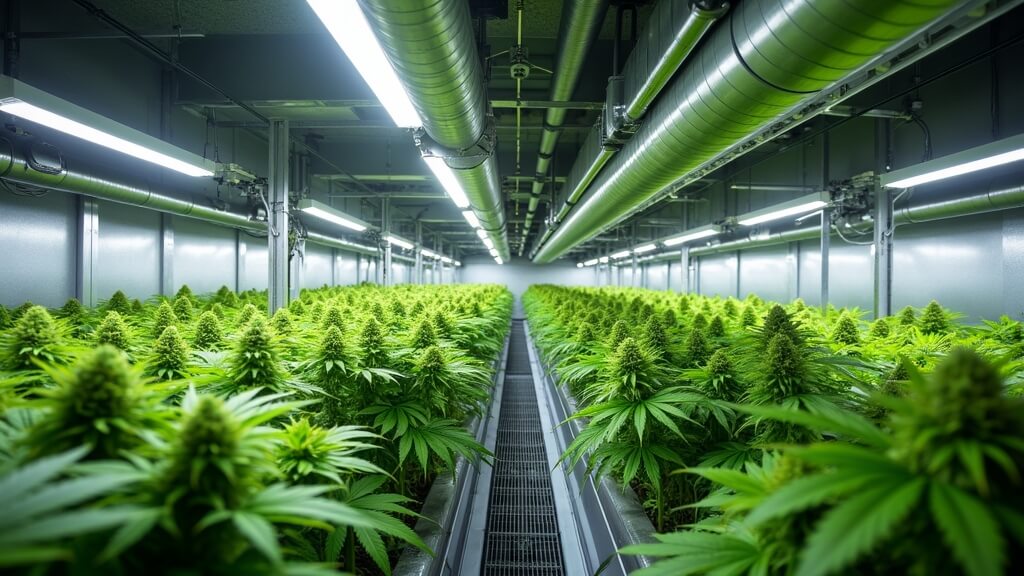
Phase 4: Operations & Scaling
Operational Cost Optimization
Running cannabis facilities efficiently requires constant attention to energy usage, maintenance procedures, and process optimization to maintain profitability in a high-cost environment.
Energy Management represents the largest operational expense for most cannabis facilities. Indoor cultivation uses up to 10 times more electricity per square foot than typical office buildings, making efficiency improvements directly impact bottom-line results.
LED lighting conversions can reduce electricity consumption by 20-30% compared to older HPS systems while generating less heat and reducing HVAC loads. Smart environmental controls that modulate lighting and climate systems based on real-time conditions provide additional savings. Some operators participate in utility demand response programs, temporarily reducing power usage during peak grid times in exchange for financial incentives.
Preventive Maintenance Programs prevent costly equipment failures and production disruptions. Regular HVAC servicing, filter changes, and sensor calibrations maintain optimal growing conditions and prevent system breakdowns that could destroy entire crops. Maintaining critical spare parts for pumps, fans, and other essential equipment prevents extended downtime when failures occur.
Process Optimization through data collection and analysis identifies inefficiencies and improvement opportunities. Tracking metrics like grams produced per kilowatt-hour, water usage per plant, or labor hours per harvest helps identify underperforming areas and benchmark against industry standards.
Labor Efficiency strategies include cross-training staff for multiple roles, developing detailed standard operating procedures for consistency, and investing in appropriate automation for repetitive tasks like irrigation or packaging. Balancing automation investments against labor flexibility requires careful analysis of operational scale and growth plans.
Continuous improvement mindset drives ongoing cost reductions and operational enhancements that compound over time.
Multi-Location Scaling Strategy
Expanding beyond single-site operations requires standardized processes, centralized management functions, and careful adaptation to local market conditions.
Standardization Foundation begins with documenting all critical processes in detailed standard operating procedures before attempting expansion. These SOPs become the playbook for new locations, ensuring consistent quality and compliance across multiple sites.
Centralized vs. Localized Functions requires strategic decisions about which activities to manage centrally versus locally. Purchasing often benefits from centralization through volume discounts and supply chain efficiency. Human resources, training programs, and compliance management typically work better with centralized oversight to ensure consistency.
Marketing and brand management usually require central coordination to maintain consistent messaging, while local adaptation addresses community-specific needs and regulations.
Technology Infrastructure should support multi-site operations through cloud-based systems for inventory tracking, security monitoring, and operational reporting. Consolidated dashboards providing real-time visibility across all locations enable proactive management and rapid issue resolution.
Regulatory Compliance becomes more complex across multiple jurisdictions with varying requirements. Dedicated compliance teams that understand different state and local regulations prevent violations that could impact multiple locations.
Quality Assurance programs spanning all facilities ensure brand consistency and product quality. Regular testing, standardized cultivation protocols, and cross-site audits maintain quality standards as operations scale.
Successful scaling requires the same care as the original operation, the right conditions, processes, and attention to detail determine whether expansion enhances or dilutes the original success.
Multi-State Expansion Considerations
Expanding across state lines adds regulatory complexity, supply chain challenges, and market analysis requirements beyond simple multi-location growth.
Licensing Strategy Decisions include applying for new licenses where available, acquiring existing operators or licenses, or partnering with local licensees through management agreements or joint ventures. Each approach offers different risk, cost, and control trade-offs.
New license applications may be less expensive but often face heavy competition, especially in limited-license states. Acquisitions provide guaranteed market entry but typically require substantial capital investment. Partnerships can minimize initial investment but may limit operational control.
Regulatory Diversity across states creates compliance challenges for standardized operations. Product formulations legal in one state may be prohibited elsewhere due to potency limits or ingredient restrictions. Packaging and labeling requirements vary significantly, sometimes requiring state-specific product versions.
Supply Chain Limitations from federal interstate commerce prohibition require self-contained operations in each state. Companies cannot ship products between state operations, necessitating cultivation or wholesale supply relationships in each market.
Market Analysis becomes critical when entering new states with different competitive landscapes, consumer preferences, and pricing dynamics. Medical-focused markets may prioritize different products than adult-use markets, requiring adjusted product mixes and marketing approaches.
Financial and Tax Complexity multiplies with each state operation facing separate 280E obligations and varying state tax structures. Corporate structure planning becomes essential for managing entity relationships and optimizing overall tax burden.
Multi-state expansion requires treating each new market as a distinct business while leveraging operational expertise and brand recognition from existing markets.
Exit Strategy Planning
Real estate ownership often represents the most valuable and stable component of cannabis businesses, making exit strategy planning inseparable from property decisions.
Real Estate as Exit Asset provides significant advantages during business sales. Owned properties can be sold with the business for premium valuations, leased to buyers for ongoing income streams, or sold separately to real estate investors while leasing back to business buyers.
Cannabis properties in limited-license states often carry substantial premiums because they’re tied to valuable licenses. Sophisticated operators sometimes structure separate sales, business and license to one buyer, real estate to another to maximize value from both cannabis M&A markets and real estate capital markets.
Valuation Considerations for cannabis businesses typically use EBITDA multiples adjusted for 280E impacts, plus license values in limited markets. Property valuations face unique challenges from limited comparable sales, uncertain tenant demand if current operators leave, and varying market conditions across cannabis sectors.
Properties tied to licenses in limited markets may command higher values due to restricted supply and sticky tenant demand. However, properties in oversupplied markets may trade closer to generic industrial or retail values if local cannabis markets struggle.
Sale-Leaseback as Semi-Exit provides capital infusion and partial risk reduction without exiting operations entirely. Many companies used this strategy during high-valuation periods to fund expansion or provide investor returns, though operators must carefully model long-term rent obligations against operational cash flows.
Acquisition Readiness requires maintaining clean financial records, documented compliance history, and strong market positions. Cannabis due diligence is particularly demanding given regulatory complexity, making preparation essential for successful exits.
Market Timing Factors significantly impact exit valuations. Federal legalization prospects, state market maturity, and overall cannabis industry conditions influence buyer interest and pricing. Properties and businesses in emerging markets may command premiums during rapid growth phases.
Exit planning should begin early in business development, influencing property ownership decisions, corporate structure choices, and operational documentation standards that facilitate eventual transactions.
Key Concepts
Cannabis real estate success requires navigating challenges far beyond typical commercial property decisions. From complex zoning restrictions and alternative financing to specialized infrastructure and multi-state compliance, every phase demands cannabis-specific expertise and strategic thinking.
The operators who thrive are those who approach real estate as a strategic asset rather than just operational necessity. Smart property decisions create competitive advantages through lower operating costs, regulatory compliance, and positioning for growth and eventual exit.
Key principles for success include conducting thorough due diligence on all regulatory and environmental factors, building strong relationships with local officials and communities, designing flexible infrastructure that can adapt to changing needs, and maintaining operational excellence that positions facilities for scaling and eventual exit.
The cannabis industry continues evolving rapidly, but real estate decisions have long-term consequences that outlast short-term market fluctuations. Operators who invest in quality locations, compliant facilities, and strong operational systems create sustainable competitive advantages regardless of market conditions.
Whether launching your first facility or planning multi-state expansion, the fundamentals remain constant: choose wisely, invest in compliance and quality, and build operations that can adapt and grow with this dynamic industry.

